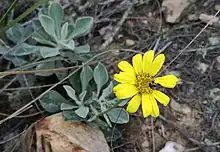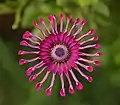| Osteospermum | |
|---|---|
 | |
| Osteospermum spinosum, the type species of the genera | |
| Scientific classification | |
| Kingdom: | Plantae |
| Clade: | Tracheophytes |
| Clade: | Angiosperms |
| Clade: | Eudicots |
| Clade: | Asterids |
| Order: | Asterales |
| Family: | Asteraceae |
| Subfamily: | Asteroideae |
| Tribe: | Calenduleae |
| Genus: | Osteospermum L. |
| Species | |
| Synonyms[1] | |
| |
Osteospermum /ˌɒstiəˈspɜːrməm, -tioʊ-/,[2][3] is a genus of flowering plants belonging to the Calenduleae, one of the smaller tribes of the sunflower/daisy family Asteraceae.[4] They are known as the daisybushes[5] or African daisies.[6] Its species have been given several common names, including African daisy, South African daisy, Cape daisy and blue-eyed daisy.
Description
Their alternate (rarely opposite) leaves are green, but some variegated forms exist. The leaf form is lanceolate. The leaf margin is entire, but hardy types are toothed.
The daisy-like composite flower consists of disc florets and ray florets, growing singly at the end of branches or sometimes in inflorescences of terminal corymbose cymes. The disc florets are pseudo-bisexual and come in several colors such as blue, yellow and purple. The hardy types usually show a dark blue center in the disc until the yellow pollen is shed. The ray florets are female and are found diverse colors such as white, cream, pink, purple, mauve to yellow. Some cultivars have "spooned" petals such as "Pink Whirls".[7] Many species flower a second time late summer, stimulated by the cooler night temperatures. Hardy types show profuse flowering in the spring, but they do not get a second flush of flowers.
Taxonomy
The genus Osteospermum was named by Carl Linnaeus in 1753. The scientific name is derived from the Greek osteon (bone) and Latin spermum (seed). Plants of the World Online and the South African National Biodiversity Institute accept a broad definition of the genus, which is a sister taxon to Dimorphotheca. Other authorities treat its generic synonyms (Chrysanthemoides, Oligocarpus, etc.) as separate genera.[1][8]
Species
74 species are accepted:[1]
- Osteospermum acanthospermum (DC.) Norl.
- Osteospermum aciphyllum DC.
- Osteospermum afromontanum Norl.
- Osteospermum amplectens (Harv.) Norl.
- Osteospermum angolense Norl.
- Osteospermum apterum (B.Nord.) J.C.Manning & Goldblatt
- Osteospermum armatum Norl.
- Osteospermum asperulum (DC.) Norl.
- Osteospermum attenuatum Hilliard & B.L.Burtt
- Osteospermum auriculatum (S.Moore) Norl.
- Osteospermum australe B.Nord.
- Osteospermum bidens Thunb.
- Osteospermum bolusii (Compton) Norl.
- Osteospermum breviradiatum Norl. — Lemoenboegoe
- Osteospermum burttianum B.Nord.
- Osteospermum calcicola (J.C.Manning & Goldblatt) J.C.Manning & Goldblatt
- Osteospermum calendulaceum L.f. — Stinking Roger
- Osteospermum ciliatum P.J.Bergius
- Osteospermum connatum DC.
- Osteospermum corymbosum L.
- Osteospermum crassifolium (O.Hoffm.) Norl.
- Osteospermum dentatum Burm.f.
- Osteospermum elsieae Norl.
- Osteospermum grandidentatum DC. — Yellow trailing daisy
- Osteospermum grandiflorum DC.
- Osteospermum hafstroemii Norl.
- Osteospermum herbaceum L.f.
- Osteospermum hirsutum Thunb.
- Osteospermum hispidum Harv.
- Osteospermum hyoseroides (DC.) Norl.
- Osteospermum ilicifolium L.
- Osteospermum imbricatum L.
- Osteospermum incanum Burm.f.
- Osteospermum junceum P.J.Bergius
- Osteospermum karrooicum (Bolus) Norl.
- Osteospermum lanceolatum DC.
- Osteospermum leptolobum (Harv.) Norl.
- Osteospermum microcarpum (Harv.) Norl.
- Osteospermum microphyllum DC.
- Osteospermum moniliferum L.
- Osteospermum monocephalum (Oliv. & Hiern) Norl.
- Osteospermum monstrosum (Burm.f.) J.C.Manning & Goldblatt
- Osteospermum montanum Klatt
- Osteospermum muricatum E.Mey. ex DC.
- Osteospermum namibense Swanepoel
- Osteospermum nervosum (Hutch.) Norl.
- Osteospermum nordenstamii J.C.Manning & Goldblatt
- Osteospermum norlindhianum J.C.Manning & Goldblatt
- Osteospermum nyikense Norl.
- Osteospermum oppositifolium (Aiton) Norl.
- Osteospermum pinnatilobatum Norl.
- Osteospermum pinnatum (Thunb.) Norl.
- Osteospermum polycephalum (DC.) Norl.
- Osteospermum polygaloides L.
- Osteospermum potbergense A.R.Wood & B.Nord.
- Osteospermum pterigoideum Klatt
- Osteospermum pyrifolium Norl.
- Osteospermum rigidum Aiton
- Osteospermum rosulatum Norl.
- Osteospermum rotundifolium (DC.) Norl.
- Osteospermum sanctae-helenae Norl.
- Osteospermum scariosum DC.
- Osteospermum sinuatum (DC.) Norl.
- Osteospermum spathulatum (DC.) Norl.
- Osteospermum spinescens Thunb.
- Osteospermum spinigerum (Norl.) Norl.
- Osteospermum spinosum L.
- Osteospermum striatum Burtt Davy
- Osteospermum subulatum DC.
- Osteospermum thodei Markötter
- Osteospermum tomentosum (L.f.) B.Nord.
- Osteospermum triquetrum L.f.
- Osteospermum vaillantii (Decne.) Norl.
- Osteospermum volkensii (O.Hoffm.) Norl.
Formerly placed here
- Dimorphotheca barberae — synonym Osteospermum barberae (Harv.) Norl.)
- Dimorphotheca ecklonis — Cape marguerite, blue-and-white daisybush (synonym Osteospermum ecklonis (DC.) Norl.)
- Dimorphotheca fruticosa — Trailing African daisy, shrubby daisybush (synonym Osteospermum fruticosum (L.) Norl.)
- Dimorphotheca jucunda (E.Phillips) Norl. — South African daisy (synonym Osteospermum jucundum E.Phillips)
Distribution
There are about 70 species native to southern and eastern Africa and the Arabian peninsula.[1]
Cultivation
Osteospermum are popular in cultivation, where they are frequently used in summer bedding schemes in parks and gardens. Numerous hybrids and cultivars have been grown with a wide range of tropical colors. Yellow cultivars tend to have a yellow center (sometimes off-white).
Plants prefer a warm and sunny position and rich soil, although they tolerate poor soil, salt or drought well. Modern cultivars flower continuously when watered and fertilised well, and dead-heading is not necessary, because they do not set seed easily. If planted in a container, soil should be prevented from drying out completely. If they do, the plants will go into "sleep mode" and survive the period of drought, but they will abort their flower buds and not easily come back into flower. Moreover, roots are relatively susceptible to rotting if watered too profusely after the dry period.
Cultivars
Most widely sold cultivars are grown as annuals, are mainly hybrids of O. jucundum, O. ecklonis and O. grandiflorum and can be hardy to -2 °C (30 °F). If hardy, they can be grown as perennials or as shrubs.
Cultivars (those marked agm have gained the Royal Horticultural Society's Award of Garden Merit):[9]

- 'Acapulco'
- 'African Queen'
- 'Apricot'
- 'Biera'
- 'Big Pink'
- ‘Blackthorn Seedling’ agm[10]
- 'Bodegas Pink'
- 'Buttermilk' agm[11]
- 'Chris Brickell'
- 'Duet'
- 'Giles Gilbey'
- 'Hopleys’ agm[12]
- 'Ice White'
- 'Langtrees agm[13]
- ’Lady Leitrim’ agm[14]
- 'Lilac Spoon'
- 'Marbella'
- 'Merriments Joy'
- 'Nairobi Purple'
- O. jucundum agm[15]
- 'Passion Mix'
- 'Pink'
- 'Pink Beauty'
- 'Pink Whirls' agm[16]
- 'Silver Sparkler' agm[17]
- 'Soprano'
- 'Starshine'
- 'Springstar Gemma'
- 'Sunkist'
- 'Weetwood' [18]
- 'White Pim' agm[19]
- 'White Spoon'
- 'White Whirls'
- 'Whirlygig'
Image gallery

 'Passion Mix'
'Passion Mix' 'Lemon Symphony' (an annual cultivar)
'Lemon Symphony' (an annual cultivar) Osteospermum 'Sunadora Hotspots Marbella', a modern hybrid
Osteospermum 'Sunadora Hotspots Marbella', a modern hybrid Osteospermum 'Sunadora Hotspots Acapulco', another modern hybrid
Osteospermum 'Sunadora Hotspots Acapulco', another modern hybrid An osteospermum displayed as part of the 2008 Penn State horticultural trials
An osteospermum displayed as part of the 2008 Penn State horticultural trials.jpg.webp) Osteospermum 'Pink Whirls'
Osteospermum 'Pink Whirls' 'Pink Whirls' close-up
'Pink Whirls' close-up


 Osteospermum Cape Daisy 'Pink bicolor'
Osteospermum Cape Daisy 'Pink bicolor' Osteospermum Sunset shades
Osteospermum Sunset shades
References
- 1 2 3 4 "Osteospermum L." Plants of the World Online. Royal Botanic Gardens, Kew. Archived from the original on 2020-08-15. Retrieved 2020-07-19.
- ↑ "Osteospermum". Lexico UK English Dictionary. Oxford University Press. Archived from the original on 2022-08-27.
- ↑ Sunset Western Garden Book, 1995:606–607
- ↑ Wood, A.R.; Nordenstam, B. (December 2003). "An interesting new species of Osteospermum (Asteraceae–Calenduleae) from the Western Cape Province, South Africa, providing a link to the genus Chrysanthemoides". South African Journal of Botany. 69 (4): 572–578. doi:10.1016/S0254-6299(15)30297-0.
- ↑ USDA, NRCS (n.d.). "Osteospermum". The PLANTS Database (plants.usda.gov). Greensboro, North Carolina: National Plant Data Team. Retrieved 26 July 2015.
- ↑ Rhoades, Heather (28 June 2021). "Growing Osteospermum: How To Care For African Daisies". Gardening Know How. Archived from the original on 1 February 2022. Retrieved 1 February 2022.
- ↑ The Garden. Vol. 122. Royal Horticultural Society. 1997. p. 510. Archived from the original on 2022-10-03. Retrieved 2022-02-05.
- ↑ Wessel Swanpoel, Vera de Cauwer and Abraham E. Van Wyk (2020) A new species of Osteospermum subgen. Tripteris (Asteraceae: Calenduleae) from the Namib Desert, Namibia. Phytotaxa 487 (3): 185–194 26 February 2021. https://doi.org/10.11646/phytotaxa.487.3.1
- ↑ "AGM Plants - Ornamental" (PDF). Royal Horticultural Society. July 2017. p. 70. Archived (PDF) from the original on 5 January 2018. Retrieved 14 April 2018.
- ↑ "RHS Plantfinder - Osteospermum 'Blackthorn Seedling'". Archived from the original on 17 April 2018. Retrieved 14 April 2018.
- ↑ "RHS Plant Selector - Osteospermum 'Buttermilk'". Archived from the original on 28 January 2021. Retrieved 16 January 2021.
- ↑ "RHS Plant Selector - Osteospermum 'Hopleys'". Archived from the original on 28 January 2021. Retrieved 16 January 2021.
- ↑ "RHS Plant Selector - Osteospermum jucundum 'Langtrees'". Retrieved 28 June 2013.
- ↑ "RHS Plantfinder - Osteospermum 'Lady Leitrim'". Archived from the original on 17 April 2018. Retrieved 14 April 2018.
- ↑ "Osteospermum jucundum". RHS. Archived from the original on 28 January 2021. Retrieved 18 January 2021.
- ↑ "RHS Plant Selector - Osteospermum 'Pink Whirls'". Archived from the original on 29 January 2021. Retrieved 16 January 2021.
- ↑ "RHS Plantfinder - Osteospermum 'Silver Sparkler'". Archived from the original on 17 April 2018. Retrieved 14 April 2018.
- ↑ "Osteospermum 'Weetwood'". RHS. Archived from the original on 29 January 2021. Retrieved 18 January 2021.
- ↑ "RHS Plant Selector - Osteospermum 'White Pim'". Archived from the original on 28 January 2021. Retrieved 16 January 2021.
Further reading
- Bussmann, R. W., et al. (2006). Plant use of the Maasai of Sekenani Valley, Maasai Mara, Kenya. J Ethnobiol Ethnomed 2 22.
- Nordenstam, B., and Bremer, Kare (editor). "Tribe Calenduleae" in: Asteraceae: Cladistics and Classification. Portland, Oregon: Timber Press, 1994. ISBN 0-88192-275-7. Pp. 365–376.
External links
- A phylogenetic study of the Calenduleae - Bertil Nordenstam and Ida Trift
- Osteospermum.com - a website with much information and many photographs
- Sunadora Osteospermums
![]() Media related to Osteospermum at Wikimedia Commons
Media related to Osteospermum at Wikimedia Commons